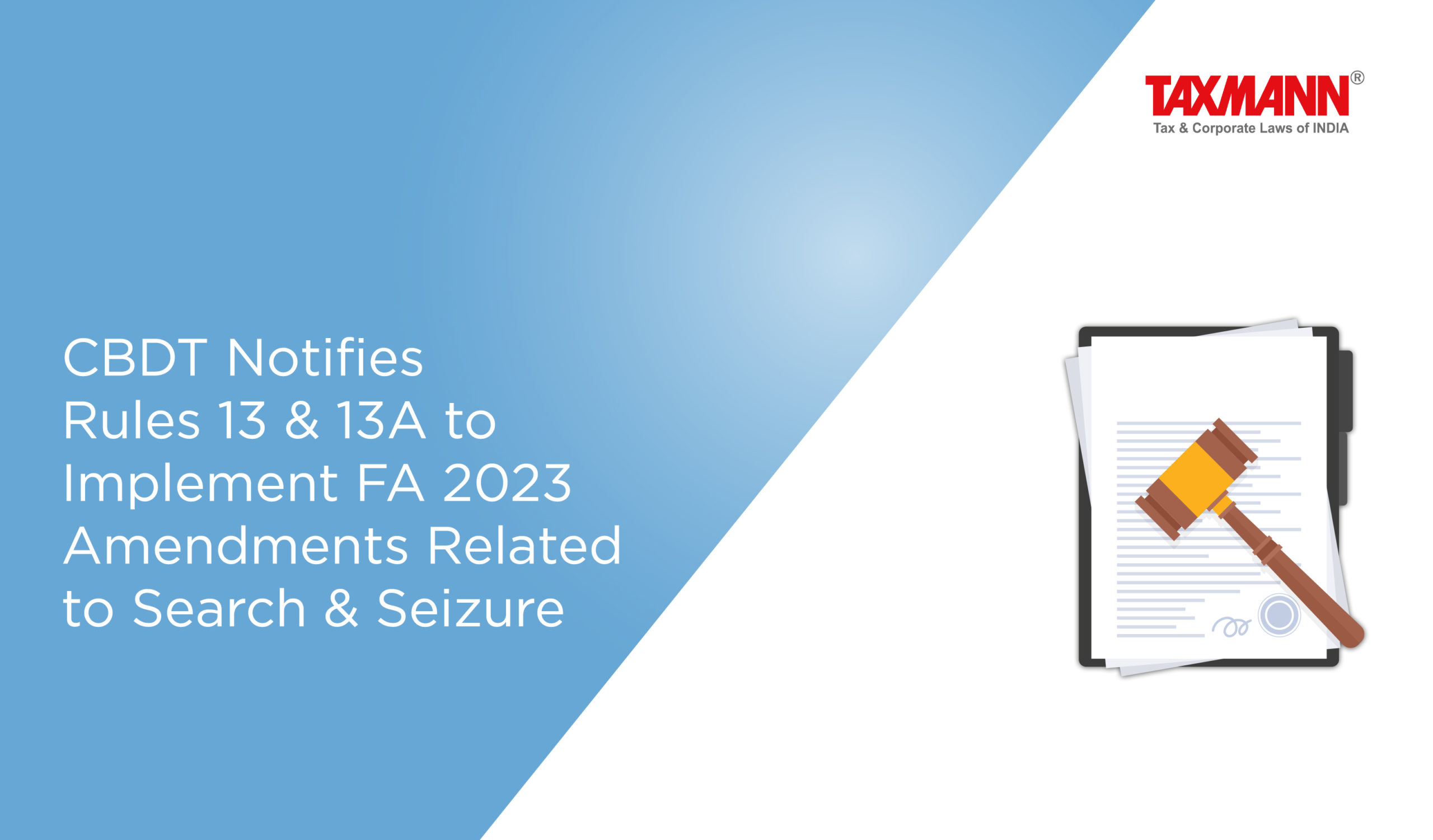CBDT Notifies Rules 13 & 13A to Implement FA 2023 Amendments Related to Search & Seizure
- News|Blog|Income Tax|
- 2 Min Read
- By Taxmann
- |
- Last Updated on 30 August, 2023
Notification No. 70/2023, dated 28-08-2023
Section 132 empowers search and seizure subject to the fulfilment of conditions specified therein. The pre-amended sub-section (2) allows the authorized person to requisition services from a police officer or any other officer of the Central Government to assist in conducting work. Similarly, the pre-amended section (9D) empowers the authorized officer to make a reference to a valuation officer under section 142A for estimating the fair value of the property.
The Finance Act 2023 amended sections 132(2) and 132(9D) to increase the scope of the respective powers of the authorized officers.
Section 132(2) was amended to include that the authorized person may requisition for the services of any person or entity from different walks and strata with the prior approval from CIT/PCIT/CCIT/PCCIT, Principal Director General or Director General.
Similarly, section 132(9D) was amended, empowering the authorized officer to requisition the services of any person or entity or any registered valuer in addition to the reference made to the Valuation Officer in accordance with section 142A with the prior approval from CIT/PCIT/CCIT/PCCIT, Principal Director General or Director General.
The Central Board of Direct Taxes (CBDT) has inserted Rules 13 and 13A to the Income-tax Rules, 1962 to implement the said amendments.
Rule 13 prescribes the procedure to requisition services under section 132(2) and to make a reference under section 132(9D). It provides that any person or entity whose services may be requisitioned or any person or entity or registered valuer to whom reference may be made shall make applicable in Form No. 6C to the Principal Chief Commissioner, the Chief Commissioner, the Principal Director General, or the Director General.
Such application must be disposed of within six months from the end of the month in which such application was made by accepting or rejecting the same.
Further, Rule 13A relates to the procedure and valuation method adopted for the valuation of any property for the purpose of section 132(9D). It provides as follows:
i) The value of immovable property, whether land or building or both, will be based on the value determined by any Central Government or State Government authority for stamp duty payment related to the property. This includes construction and improvement costs, if applicable, on the dates specified under the reference from section 132(9D).
ii) The value of jewellery, archaeological collections, art, shares, or securities mentioned in rule 11UA will be determined as per sub-rule (1) of rule 11UA.
iii) For properties not covered by (i) or (ii), or if the valuation isn’t possible, the value shall be the sale price in the open market on the relevant valuation date.
The Valuation report must be submitted by such person, entity or registered valuer in Form No. 6CA.
Click Here To Read The Full Notification
Disclaimer: The content/information published on the website is only for general information of the user and shall not be construed as legal advice. While the Taxmann has exercised reasonable efforts to ensure the veracity of information/content published, Taxmann shall be under no liability in any manner whatsoever for incorrect information, if any.

Taxmann Publications has a dedicated in-house Research & Editorial Team. This team consists of a team of Chartered Accountants, Company Secretaries, and Lawyers. This team works under the guidance and supervision of editor-in-chief Mr Rakesh Bhargava.
The Research and Editorial Team is responsible for developing reliable and accurate content for the readers. The team follows the six-sigma approach to achieve the benchmark of zero error in its publications and research platforms. The team ensures that the following publication guidelines are thoroughly followed while developing the content:
- The statutory material is obtained only from the authorized and reliable sources
- All the latest developments in the judicial and legislative fields are covered
- Prepare the analytical write-ups on current, controversial, and important issues to help the readers to understand the concept and its implications
- Every content published by Taxmann is complete, accurate and lucid
- All evidence-based statements are supported with proper reference to Section, Circular No., Notification No. or citations
- The golden rules of grammar, style and consistency are thoroughly followed
- Font and size that’s easy to read and remain consistent across all imprint and digital publications are applied








 CA | CS | CMA
CA | CS | CMA


